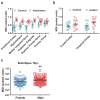Generation of a microglial developmental index in mice and in humans reveals a sex difference in maturation and immune reactivity
- PMID: 28618077
- PMCID: PMC5540146
- DOI: 10.1002/glia.23176
Generation of a microglial developmental index in mice and in humans reveals a sex difference in maturation and immune reactivity
Erratum in
-
Generation of a microglial developmental index in mice and in humans reveals a sex difference in maturation and immune reactivity.Glia. 2018 Feb;66(2):460. doi: 10.1002/glia.23277. Glia. 2018. PMID: 29230901 No abstract available.
Abstract
Evidence suggests many neurological disorders emerge when normal neurodevelopmental trajectories are disrupted, i.e., when circuits or cells do not reach their fully mature state. Microglia play a critical role in normal neurodevelopment and are hypothesized to contribute to brain disease. We used whole transcriptome profiling with Next Generation sequencing of purified developing microglia to identify a microglial developmental gene expression program involving thousands of genes whose expression levels change monotonically (up or down) across development. Importantly, the gene expression program was delayed in males relative to females and exposure of adult male mice to LPS, a potent immune activator, accelerated microglial development in males. Next, a microglial developmental index (MDI) generated from gene expression patterns obtained from purified mouse microglia, was applied to human brain transcriptome datasets to test the hypothesis that variability in microglial development is associated with human diseases such as Alzheimer's and autism where microglia have been suggested to play a role. MDI was significantly increased in both Alzheimer's Disease and in autism, suggesting that accelerated microglial development may contribute to neuropathology. In conclusion, we identified a microglia-specific gene expression program in mice that was used to create a microglia developmental index, which was applied to human datasets containing heterogeneous cell types to reveal differences between healthy and diseased brain samples, and between males and females. This powerful tool has wide ranging applicability to examine microglial development within the context of disease and in response to other variables such as stress and pharmacological treatments.
Keywords: development; microglia; sex differences; whole transcriptome analysis.
© 2017 Wiley Periodicals, Inc.
Conflict of interest statement
The authors declare no competing financial interests.
Figures






Similar articles
-
Sexually divergent induction of microglial-associated neuroinflammation with hippocampal aging.J Neuroinflammation. 2017 Jul 21;14(1):141. doi: 10.1186/s12974-017-0920-8. J Neuroinflammation. 2017. PMID: 28732515 Free PMC article.
-
The Transcriptional Landscape of Microglial Genes in Aging and Neurodegenerative Disease.Front Immunol. 2019 Jun 4;10:1170. doi: 10.3389/fimmu.2019.01170. eCollection 2019. Front Immunol. 2019. PMID: 31214167 Free PMC article.
-
Microglial senescence contributes to female-biased neuroinflammation in the aging mouse hippocampus: implications for Alzheimer's disease.J Neuroinflammation. 2023 Aug 16;20(1):188. doi: 10.1186/s12974-023-02870-2. J Neuroinflammation. 2023. PMID: 37587511 Free PMC article.
-
Next generation transcriptomics and genomics elucidate biological complexity of microglia in health and disease.Glia. 2016 Feb;64(2):197-213. doi: 10.1002/glia.22866. Epub 2015 Jun 4. Glia. 2016. PMID: 26040959 Review.
-
Microglia along sex lines: From brain colonization, maturation and function, to implication in neurodevelopmental disorders.Semin Cell Dev Biol. 2019 Oct;94:152-163. doi: 10.1016/j.semcdb.2019.06.001. Epub 2019 Jun 22. Semin Cell Dev Biol. 2019. PMID: 31201858 Review.
Cited by
-
Minding the Gap: Exploring Neuroinflammatory and Microglial Sex Differences in Alzheimer's Disease.Int J Mol Sci. 2023 Dec 12;24(24):17377. doi: 10.3390/ijms242417377. Int J Mol Sci. 2023. PMID: 38139206 Free PMC article. Review.
-
The microbiota-microglia axis in central nervous system disorders.Brain Pathol. 2020 Nov;30(6):1159-1177. doi: 10.1111/bpa.12908. Epub 2020 Nov 5. Brain Pathol. 2020. PMID: 33073887 Free PMC article. Review.
-
Impact of prenatal maternal cytokine exposure on sex differences in brain circuitry regulating stress in offspring 45 years later.Proc Natl Acad Sci U S A. 2021 Apr 13;118(15):e2014464118. doi: 10.1073/pnas.2014464118. Proc Natl Acad Sci U S A. 2021. PMID: 33876747 Free PMC article.
-
Exercise and the Aging Brain: Considerations for Sex Differences.Brain Plast. 2018 Dec 12;4(1):53-63. doi: 10.3233/BPL-180067. Brain Plast. 2018. PMID: 30564546 Free PMC article. Review.
-
Differential Neuroinflammatory Response in Male and Female Mice: A Role for BDNF.Front Mol Neurosci. 2019 Jul 17;12:166. doi: 10.3389/fnmol.2019.00166. eCollection 2019. Front Mol Neurosci. 2019. PMID: 31379496 Free PMC article.
References
-
- Cahoy JD, Emery B, Kaushal A, Foo LC, Zamanian JL, Christopherson KS, … Barres BA. A transcriptome database for astrocytes, neurons, and oligodendrocytes: a new resource for understanding brain development and function. J Neurosci. 2008;28(1):264–278. doi: 10.1523/JNEUROSCI.4178-07.2008. - DOI - PMC - PubMed
MeSH terms
Substances
Grants and funding
LinkOut - more resources
Full Text Sources
Other Literature Sources
Molecular Biology Databases

